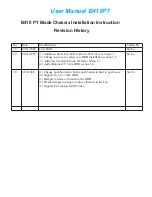
NOTE:
1.
a
Sled Configuration Details
2.
Minimum: Each MX740c is configured with 2x 85W CPUs, 12x 16 GB DIMMs, 2x 2.5” SATA HDDs, 1x 25Gb Mezz card, 1x
H740 PERC
3.
Typical: Each MX740c is configured with 2x 145W CPUs, 12x 32 GB DIMMs, 6x 1600 GB SAS SSD, 2x 25GB Mezz cards,
1x H740P PERC, 1x Fiber-channel mini Mezz
4.
Each MX840c is configured with 4x 165W CPUs, 48x 16 GB DIMMs, 8x 1600 GB NVMe SSD, 4x 25GB Mezz cards, 2x
Fiber-channel mini Mezz, 1x H740P PERC
5.
Feature-Rich: Each MX740c is configured with 2x 165W CPUs, 24x 32 GB DIMMs, 6x 1600 GB NVMe SSD, 2x 25GB
Mezz cards, 1x H740P PERC
6.
Each MX5016s is configured with 16x 1600GB SSD
7.
b
LwA-UL is the upper limit sound power levels (LwA) calculated per section 4.4.1 of ISO 9296 (1988) and measured in
accordance to ISO 7779 (2010)
8.
c
Idle values are recorded when server is powered on with only the operating system running
9.
d
Prominent tone: Criteria of D.6 and D.11 of ECMA-74 13th ed. (2015) are followed to determine if discrete tones are
prominent. The acoustic transducers are located at front and rear bystander positions. The system is placed in a 42U rack
enclosure, 75cm above the reflective floor.
Acoustical Baffle
The acoustical baffle is an optional add-on developed for MX7000 to provide reduced acoustics and improved sound quality for
discerning customers. The baffle attaches to the rear of the chassis and provides attenuation of acoustics related to the rear fans
(sled cooling). The baffle is designed for tool-less attachment. The baffle has minimal impact to chassis airflow, but is not
recommended for higher wattage CPUs (>140W TDP) in environments where ambient exceeds 35°C. Under these conditions,
system performance may be impacted by the baffle.
CAUTION: The acoustical baffle is not designed to support the weight of cables, therefore no cables should be attached
to, or rest on, the baffle.
Sound Cap
Sound cap is a new custom thermal profile designed for customers that temporarily require reduced acoustics (reboot required) and
are willing to accept some reduced performance. Sound cap works by applying a percentage power cap to the CPUs in the sled.
Sound cap is only available on MX740c and MX840c sleds. Sound cap is not available as a chassis-level setting.
Acoustical Dependencies
The following statements reflect the most important system configuration dependencies that drive acoustical experience:
•
Generally, the sled fans (rear fan modules) are the loudest component in the system, therefore reducing the thermal load on
individual sleds is the most successful approach to reducing acoustics.
•
For compute sled configurations (MX740c & MX840c), CPU thermal design power (TDP) and CPU case temperature
requirements drive the cooling requirements of the sled for most workloads. Lower TDP processors coupled with workload
scheduling may reduce acoustics.
•
For IOM-A/B options, the best acoustics are achieved with 10G, 25Gb modules, and fabric expander (MX7116n) modules,
moderate acoustical experience can be achieved with the switching module (MX5108n), while the fabric switching module
(MX9116n) has the loudest acoustical experience.
•
For IOM-C options, SAS storage IOM (MX5000s) requires less cooling than the fiber channel module (MXG610s) thus lower
acoustics.
•
When sled slots are empty, blanks must be installed to achieve efficient cooling for sleds. Inefficient cooling induces unnecessarily
loud acoustics
26



































